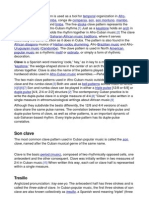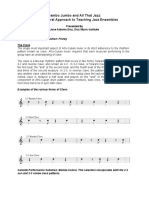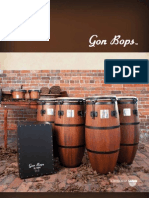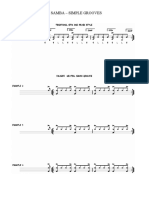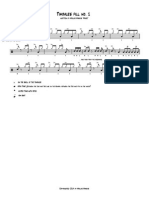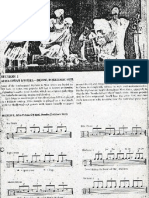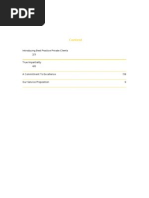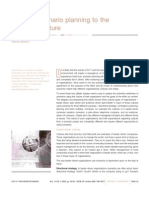Conga de Comparsa
Conga de Comparsa
Uploaded by
JOAODANIELMUSICOCopyright:
Available Formats
Conga de Comparsa
Conga de Comparsa
Uploaded by
JOAODANIELMUSICOCopyright
Available Formats
Share this document
Did you find this document useful?
Is this content inappropriate?
Copyright:
Available Formats
Conga de Comparsa
Conga de Comparsa
Uploaded by
JOAODANIELMUSICOCopyright:
Available Formats
CONGA DE COMPARSA
Conga de Comparsa is the name given to the rhythm/dance of the Cuban Carnaval, the annual street festival celebrated all over Cuba. It has a cast of hundreds that includes costumed dancers, flag bearers, farolas (large poles decorated with colorful ornaments and colored lights), singers, and a battery of percussion. The celebration can be compared to Carnaval in Brazil (with its samba schools) and Mardi Gras in New Orleans - loud, frantic and boisterous, just like its colorful history. The origins of Cuban Carnaval started during the early Spanish colonization of Cuba, when cabildos (groups that were organized to maintain their particular cultural heritage) would be allowed to play their music, dance and sing freely, celebrating all their various musical cultures (Yoruba, Bant/Congolese, Dahomey, Carabal) . This festival coincided with the Christian holiday known as the Day Of the Children (Dia de los Nios) which is celebrated January 6th. The Cuban Carnaval/Comparsa tradition was introduced in Havana in the early 19th century, when slaves marched to the Capitans General Palace to perform for the various government dignitaries present. Eventually these parades became highly competitive events with a panel of judges ( which included a dancer, percussionist, and a visual artist) who awarded trophies to the most original, colorful, and exciting comparsa. After slavery's end, Carnaval continued but was eventually moved to February to coincide with the beginning of Lent, a tradition that still continues all over Havana. The music of Conga/Comparsa is a hybrid of many styles from various African musical cultures. Out of these musics emerged two distinct styles : the Conga Oriental (from the eastern part of Cuba) and the Conga Habanera (from Havana).
CONGA HABANERA
The Conga Habanera was the original Comparsa and used many of the instruments found in Rumba. It consisted of tumbadoras (low, medium and high), bombos (small bass drums), the quinto (solo drum, which improvises), sartenes (a set of frying pans inverted and fastened to a wooden box which was strapped around the neck and played with metal beaters), cowbells, and shakers (marugas). The distinctive difference between the two styles was the use of the snare drum (redoblante) in the Havana Comparsa, which was a military influence and gave the ensemble a marching quality. In addition to the large percussion battery, a solo voice and choir would sing specifically composed songs in Spanish or popular songs adapted to Carnaval. As Comparsa grew in size and volume, singers gave way to brass ensembles (in Havana) eventually returning to vocal soloists with amplification. Starting in the 1950s trucks and tractors were used to pull the carrosas (floats) and carry amplified acoustic instruments (piano, saxes and drum sets) down the parade route. Comparsa takes control of Cuba during Carnaval, with thousands of people following the various groups in a festival like atmosphere, singing and dancing to the rhythm of the Conga.
56.
You might also like
- Twelve Patients Life and Death at Bellevu - Eric ManheimerDocument317 pagesTwelve Patients Life and Death at Bellevu - Eric ManheimerVoicu Andreea89% (9)
- Bajo Cajon: Construction and Dimensions.Document5 pagesBajo Cajon: Construction and Dimensions.rumbainstrumentsNo ratings yet
- Yoga Sculpt ScriptDocument31 pagesYoga Sculpt Scriptalan0% (1)
- The Jazz Cadence of American Culture PDFDocument2 pagesThe Jazz Cadence of American Culture PDFRolo Trombonista0% (1)
- TIRIBA and Other SongsDocument8 pagesTIRIBA and Other SongskaroNo ratings yet
- LP01Document16 pagesLP01Rachid Atia100% (1)
- Babatunde Olatunji - African DrummingDocument1 pageBabatunde Olatunji - African DrummingElisa PortillaNo ratings yet
- Clave ConceptsDocument24 pagesClave Conceptsplanetacomplice100% (2)
- Percusion Latina PDFDocument34 pagesPercusion Latina PDFMiguel Crespo100% (3)
- GbereduDocument3 pagesGbereduOnanisław Spermacy WyfiutkiewiczNo ratings yet
- History of SambaDocument2 pagesHistory of SambaMillescent Kate DavilaNo ratings yet
- Afro Cuban IntroductionDocument2 pagesAfro Cuban IntroductionEdgar Jones100% (1)
- Samba Enredo SticksDocument1 pageSamba Enredo SticksChristian Lechthaler100% (1)
- Azu Etd 14181 Sip1 M PDFDocument287 pagesAzu Etd 14181 Sip1 M PDFAngelDrumsRock100% (1)
- Chart 26: 6/8 or "Afro Clave" Cowbell PatternDocument1 pageChart 26: 6/8 or "Afro Clave" Cowbell PatternFiorella UmNo ratings yet
- Rendon PASIC09Document6 pagesRendon PASIC09Richie Torres100% (2)
- MozambiqueDocument5 pagesMozambiqueDarcila Aguirre100% (1)
- Clave Matrix IntroductionDocument4 pagesClave Matrix Introductionunlockingclave100% (1)
- The Clave Rhythmic Pattern Is Used As A Tool For Temporal Organization in AfroDocument1 pageThe Clave Rhythmic Pattern Is Used As A Tool For Temporal Organization in AfroAbel MarcelNo ratings yet
- CLAVE CONCEPTS Afro Cuban RhythmsDocument2 pagesCLAVE CONCEPTS Afro Cuban RhythmsDavid Mercado Morales100% (3)
- Drum Section - Bateria: The Soul of The ParadeDocument7 pagesDrum Section - Bateria: The Soul of The ParadeAndre Skowronski100% (2)
- Djembe TUTORIAL - Playing On BeatsDocument2 pagesDjembe TUTORIAL - Playing On BeatsLouis Cesar EwandeNo ratings yet
- Branly Afro Cuban SamplerDocument6 pagesBranly Afro Cuban SamplerLuciano Yapur0% (1)
- PearlAFRO PDFDocument8 pagesPearlAFRO PDFJarne Claesen100% (1)
- Jose Antonio DiazDocument6 pagesJose Antonio DiazMarco Serafino100% (3)
- Jonathan Gregory - The Essence of Afro-Cuban RumbaDocument3 pagesJonathan Gregory - The Essence of Afro-Cuban Rumbajaviverson87100% (1)
- Sept Brazil PDFDocument8 pagesSept Brazil PDFMiguel Ângelo Brasil100% (1)
- NullDocument73 pagesNullapi-14803215No ratings yet
- Eddie Palmieri - Two Timbale Solos As Played by Manny OQuendoDocument6 pagesEddie Palmieri - Two Timbale Solos As Played by Manny OQuendoMarcos Iniesta100% (1)
- Guaguanco For Drumset: (De La Habana)Document1 pageGuaguanco For Drumset: (De La Habana)Christian Lechthaler100% (1)
- Imagenes ChachalokafunDocument160 pagesImagenes ChachalokafunHarry GarciaNo ratings yet
- PercussaoDoBrasil Reference ManualDocument10 pagesPercussaoDoBrasil Reference ManualUSB30No ratings yet
- Huayno. Music of Perú Vol. 2Document10 pagesHuayno. Music of Perú Vol. 2JesúsNo ratings yet
- Afrocuban Percussion Instructional ManualsDocument2 pagesAfrocuban Percussion Instructional Manualsluis fernando ortegaNo ratings yet
- Djole PDFDocument1 pageDjole PDFgerardo20086854No ratings yet
- D Locke AgbadzaDocument92 pagesD Locke AgbadzaholloaurelNo ratings yet
- Smith, Andy (DM Percussion)Document140 pagesSmith, Andy (DM Percussion)Ţugui Liviu100% (1)
- Tambores BatáDocument7 pagesTambores BatáFrancisco Bascur SánchezNo ratings yet
- Afro Cuban SongsDocument3 pagesAfro Cuban SongselsalenNo ratings yet
- Son Cubano GenreDocument25 pagesSon Cubano GenreLucky Elueme100% (1)
- Samba Drumming Log BookDocument11 pagesSamba Drumming Log BookBonzo95No ratings yet
- Basic SongoDocument2 pagesBasic SongoJack PollittNo ratings yet
- Highlife RootsDocument67 pagesHighlife RootsDaniel Do AmaralNo ratings yet
- Cuban With Hilario DuranDocument14 pagesCuban With Hilario Duran김남훈No ratings yet
- CatalogDocument24 pagesCatalogAngus ChowNo ratings yet
- 017 SambaDocument12 pages017 SambarobbieNo ratings yet
- Timbales Fill No - 1 Written by Markos MiklósDocument1 pageTimbales Fill No - 1 Written by Markos Miklósmikeepercussion100% (1)
- Clave-Mambo Bell & Bongo Bell PatternsDocument1 pageClave-Mambo Bell & Bongo Bell PatternsbukugendangNo ratings yet
- Latin Percussion 2Document30 pagesLatin Percussion 2CarlosNo ratings yet
- Afro Cuban RhythmsDocument50 pagesAfro Cuban RhythmshertomaNo ratings yet
- Santana BandDocument11 pagesSantana Bandmrnogood100% (1)
- MAS Field ExperimentDocument2 pagesMAS Field ExperimentYusufRoshd100% (1)
- Grooves and Waves Cyclicity and Narrativ PDFDocument23 pagesGrooves and Waves Cyclicity and Narrativ PDFdiego maineri100% (1)
- Tunesheet-A4 5Document50 pagesTunesheet-A4 5Rob KitchenNo ratings yet
- Cuban Drumset PDFDocument10 pagesCuban Drumset PDFLucio Llon100% (1)
- Afro-Cuban - SyncopationDocument6 pagesAfro-Cuban - SyncopationBonjun Ku100% (1)
- VOLCAN Press KitDocument11 pagesVOLCAN Press KitJosmer De Abreu100% (1)
- Calipso Venezolano PDFDocument11 pagesCalipso Venezolano PDFcarloselmusico7No ratings yet
- Group WellnessDocument16 pagesGroup WellnessNathaniel TuralNo ratings yet
- Folk DancesDocument8 pagesFolk DancesScribdTranslationsNo ratings yet
- Daniel 1991Document10 pagesDaniel 1991MowNo ratings yet
- Hotel ConfirmationDocument2 pagesHotel ConfirmationPaulus TuduNo ratings yet
- Ethiopian Investment Board Industrial Parks Directive No. 06 2017Document21 pagesEthiopian Investment Board Industrial Parks Directive No. 06 2017fasika mulgetaNo ratings yet
- Tragedi KanjuruhanDocument12 pagesTragedi KanjuruhanArkarna Desak KumaratunggaNo ratings yet
- Homo Ludens ReloadedDocument15 pagesHomo Ludens ReloadedM SilvaNo ratings yet
- Memo DSPC 2024Document16 pagesMemo DSPC 2024Emma ReyesNo ratings yet
- Block 6Document51 pagesBlock 6The IndianNo ratings yet
- Introducing Best Practice Private Clients 2/3 True Impartiality 4/6Document15 pagesIntroducing Best Practice Private Clients 2/3 True Impartiality 4/6Nichole LopezNo ratings yet
- Elerick Ron 1976 Malawi PDFDocument4 pagesElerick Ron 1976 Malawi PDFthe missions networkNo ratings yet
- SATIP-T-744-01 Rev 7Document5 pagesSATIP-T-744-01 Rev 7sajidNo ratings yet
- Transportation Problems in Developing Countries PaDocument11 pagesTransportation Problems in Developing Countries PaShaista KiranNo ratings yet
- USSTSCC Press Release 9-26-23Document2 pagesUSSTSCC Press Release 9-26-23Alaska's News SourceNo ratings yet
- CRPC P PDFDocument20 pagesCRPC P PDFsai kiran gudisevaNo ratings yet
- Mettu University Engineering & Technology College Department of Construction Technology and ManagementDocument29 pagesMettu University Engineering & Technology College Department of Construction Technology and Managementyeabtsega100% (1)
- 1st Merit List BS Physics E Institute of Physics BAHAWALNAGAR Open Merit Fall 2021 Fall 2021Document1 page1st Merit List BS Physics E Institute of Physics BAHAWALNAGAR Open Merit Fall 2021 Fall 2021Muhammad AhmadNo ratings yet
- Name of National Artist MusiccDocument7 pagesName of National Artist MusiccJericho PNNo ratings yet
- Company Profile - Aakar ExhibitionDocument13 pagesCompany Profile - Aakar ExhibitionDinesh PunjabiNo ratings yet
- Objectives of Marketing ProcessDocument6 pagesObjectives of Marketing ProcessMamta VermaNo ratings yet
- Practice Test No.01: A.Ngữ âm I.Tìm từ có phần gạch chân phát âm khácDocument6 pagesPractice Test No.01: A.Ngữ âm I.Tìm từ có phần gạch chân phát âm khácHoàng OanhNo ratings yet
- Thesis Statement of Causes of Air PollutionDocument8 pagesThesis Statement of Causes of Air Pollutionlizbrowncapecoral100% (2)
- Task 1Document2 pagesTask 1Linh NguyễnNo ratings yet
- Florida Democrats 2016Document13 pagesFlorida Democrats 2016Brett LoGiuratoNo ratings yet
- Cultures of Creativity Lego Fonden 2013 PDFDocument48 pagesCultures of Creativity Lego Fonden 2013 PDFMariana MarinaNo ratings yet
- H-1-Contractor HCT EHSMS Agreement FormDocument2 pagesH-1-Contractor HCT EHSMS Agreement FormRex Santos100% (1)
- Proposal Entry Form-OMMASDocument1 pageProposal Entry Form-OMMASSANDEEP GAWANDENo ratings yet
- Acct Statement XX0116 07102024Document10 pagesAcct Statement XX0116 07102024gunadhonibilla1No ratings yet
- Tailoring Scenario Planning To The Company Culture: David MasonDocument4 pagesTailoring Scenario Planning To The Company Culture: David MasonShaffri SabriNo ratings yet
- CITESDocument2 pagesCITESkaliiimuddin123No ratings yet
- Stratus Redundant Linux Release 3.0.0.2 Release NotesDocument11 pagesStratus Redundant Linux Release 3.0.0.2 Release NotesJoeNo ratings yet











